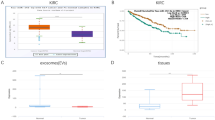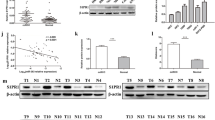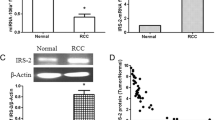Abstract
Recently, the role of miR-30a in tumor development has attracted extensive attention. In this study, we aimed to elucidate the role of miR-30a and its associated target low-density lipoprotein receptor-related protein 6 (LRP6) in clear cell renal cell carcinoma (ccRCC) cells. Here, miR-30a was markedly down-regulated in ccRCC tissues and cells, and was correlated with the advanced TNM stage and poor prognosis. By contrast, LRP6 protein level was increased in ccRCC specimens and cell lines, and inversely correlated with miR-30a expression. Stable overexpression of miR-30a suppressed cell proliferation in vitro, impeded tumor growth in vivo, prevented migration and invasion, and triggered apoptosis of ccRCC cells. Also, over-expression of miR-30a in ccRCC cells promoted the expression of the epithelial marker E-cadherin and reduced the levels of mesenchymal markers. Mechanistically, the dual-luciferase reporter, RNA immunoprecipitation and western blot assays confirmed that miR-30a directly targeted the 3′-untranslated regions of LRP6 to inhibit its expression. Further, miR-30a-mediated effect was partially reversed by co-transfection with LRP6 plasmids or enhanced by silencing of LRP6. In conclusion, miR-30a exhibits effective antitumor properties by targeting LRP6 in proliferation and metastasis of ccRCC. This study could provide new insights into the treatment of ccRCC.






Similar content being viewed by others
References
Steinhagen E, Moore HG, Lee-Kong SA, et al. Patients with colorectal and renal cell carcinoma diagnoses appear to be at risk for additional malignancies. Clin Colorect Cancer. 2013;12:23–7.
Choueiri TK, Hessel C, Halabi S, et al. Cabozantinib versus sunitinib as initial therapy for metastatic renal cell carcinoma of intermediate or poor risk (Alliance A031203 CABOSUN randomised trial): progression-free survival by independent review and overall survival update. Eur J Cancer. 2018;94:115–25.
Smith AD, Zhang X, Bryan J, et al. Vascular tumor burden as a new quantitative CT biomarker for predicting metastatic RCC response to antiangiogenic therapy. Radiology. 2016;281:484–98.
Motzer RJ, Escudier B, Powles T, et al. Long-term follow-up of overall survival for cabozantinib versus everolimus in advanced renal cell carcinoma. Br J Cancer. 2018;118:1176–8.
Mirzaei H, Masoudifar A, Sahebkar A, et al. MicroRNA: a novel target of curcumin in cancer therapy. J Cell Physiol. 2018;233:3004–15.
Bertoli G, Cava C, Castiglioni I. MicroRNAs: new biomarkers for diagnosis, prognosis, therapy prediction and therapeutic tools for breast cancer. Theranostics. 2015;5:1122–43.
Handa H, Murakami Y, Ishihara R, et al. The role and function of microRNA in the pathogenesis of multiple myeloma. Cancers (Basel). 2019;11:1738.
Orso F, Quirico L, Dettori D, et al. Role of miRNAs in tumor and endothelial cell interactions during tumor progression. Semin Cancer Biol. 2020;60:214–24.
Chen M, Calin GA, Meng QH. Circulating microRNAs as promising tumor biomarkers. Adv Clin Chem. 2014;67:189–214.
Wu M, Jolicoeur N, Li Z, et al. Genetic variations of microRNAs in human cancer and their effects on the expression of miRNAs. Carcinogenesis. 2008;29:1710–6.
Xi Y, Shalgi R, Fodstad O, et al. Differentially regulated micro-RNAs and actively translated messenger RNA transcripts by tumor suppressor p53 in colon cancer. Clin Cancer Res. 2006;12:2014–24.
Zhang B, Wang Q, Pan X. MicroRNAs and their regulatory roles in animals and plants. J Cell Physiol. 2007;210:279–89.
Zhang A, Liu Y, Shen Y, et al. miR-21 modulates cell apoptosis by targeting multiple genes in renal cell carcinoma. Urology. 2011;78(474):e13–9.
Guo Z, Lv X, Jia H. MiR-186 represses progression of renal cell cancer by directly targeting CDK6. Hum Cell. 2020;33:759–67.
Jiang LH, Zhang HD, Tang JH. MiR-30a: a Novel Biomarker and Potential Therapeutic Target for Cancer. J Oncol. 2018;2018:5167829.
Świtlik W, Karbownik MS, Suwalski M, et al. miR-30a-5p together with miR-210-3p as a promising biomarker for non-small cell lung cancer: a preliminary study. Cancer Biomark. 2018;21:479–88.
Park YR, Kim SL, Lee MR, et al. MicroRNA-30a-5p (miR-30a) regulates cell motility and EMT by directly targeting oncogenic TM4SF1 in colorectal cancer. J Cancer Res Clin Oncol. 2017;143:1915–27.
Liu Z, Chen L, Zhang X, et al. RUNX3 regulates vimentin expression via miR-30a during epithelial-mesenchymal transition in gastric cancer cells. J Cell Mol Med. 2014;18:610–23.
Kawaguchi T, Yan L, Qi Q, et al. Overexpression of suppressive microRNAs, miR-30a and miR-200c are associated with improved survival of breast cancer patients. Sci Rep. 2017;7:15945.
Thiery JP, Acloque H, Huang RY, et al. Epithelial-mesenchymal transitions in development and disease. Cell. 2009;139:871–90.
Cursons J, Pillman KA, Scheer KG, et al. Combinatorial targeting by microRNAs co-ordinates post-transcriptional control of EMT. Cell Syst. 2018;7(77–91):e7.
Huang C, Chen YJ, Chen WJ, et al. Combined treatment with chrysin and 1,2,3,4,6-penta-O-galloyl-β-d-glucose synergistically inhibits LRP6 and Skp2 activation in triple-negative breast cancer and xenografts. Mol Carcinog. 2015;54:1613–25.
Go GW. Low-density lipoprotein receptor-related protein 6 (LRP6) is a novel nutritional therapeutic target for hyperlipidemia, non-alcoholic fatty liver disease, and atherosclerosis. Nutrients. 2015;7:4453–64.
Harriott AM, Heckman MG, Rayaprolu S, et al. Low density lipoprotein receptor related protein 1 and 6 gene variants and ischaemic stroke risk. Eur J Neurol. 2015;22:1235–41.
Zhu Y, Wang M, Zhao X, et al. Rottlerin as a novel chemotherapy agent for adrenocortical carcinoma. Oncotarget. 2017;8:22825–34.
Xiao YF, Yong X, Tang B, et al. Notch and Wnt signaling pathway in cancer: crucial role and potential therapeutic targets (Review). Int J Oncol. 2016;48:437–49.
Author information
Authors and Affiliations
Corresponding author
Ethics declarations
Conflicts of interest
The author(s) declared no potential conflicts of interest with respect to the research, authorship, and/or publication of this article.
Informed consent
The human study was approved by the Ethics Committee of Shandong Provincial Third Hospital (SLSY-H-201714). All the samples were collected with written informed consent in accordance with the Declaration of Helsinki. All experimental animal procedures in this study conformed to the National Institutes of Health Guide for the Care and Use of Laboratory Animals, and were approved by the Institutional Animal Care and Use Committee of Shandong Provincial Third Hospital (SLSY-A-201803).
Additional information
Publisher's Note
Springer Nature remains neutral with regard to jurisdictional claims in published maps and institutional affiliations.
Rights and permissions
About this article
Cite this article
Ren, Y., Zhang, L., Zhang, W. et al. MiR-30a suppresses clear cell renal cell carcinoma proliferation and metastasis by targeting LRP6. Human Cell 34, 598–606 (2021). https://doi.org/10.1007/s13577-020-00472-1
Received:
Accepted:
Published:
Issue Date:
DOI: https://doi.org/10.1007/s13577-020-00472-1




